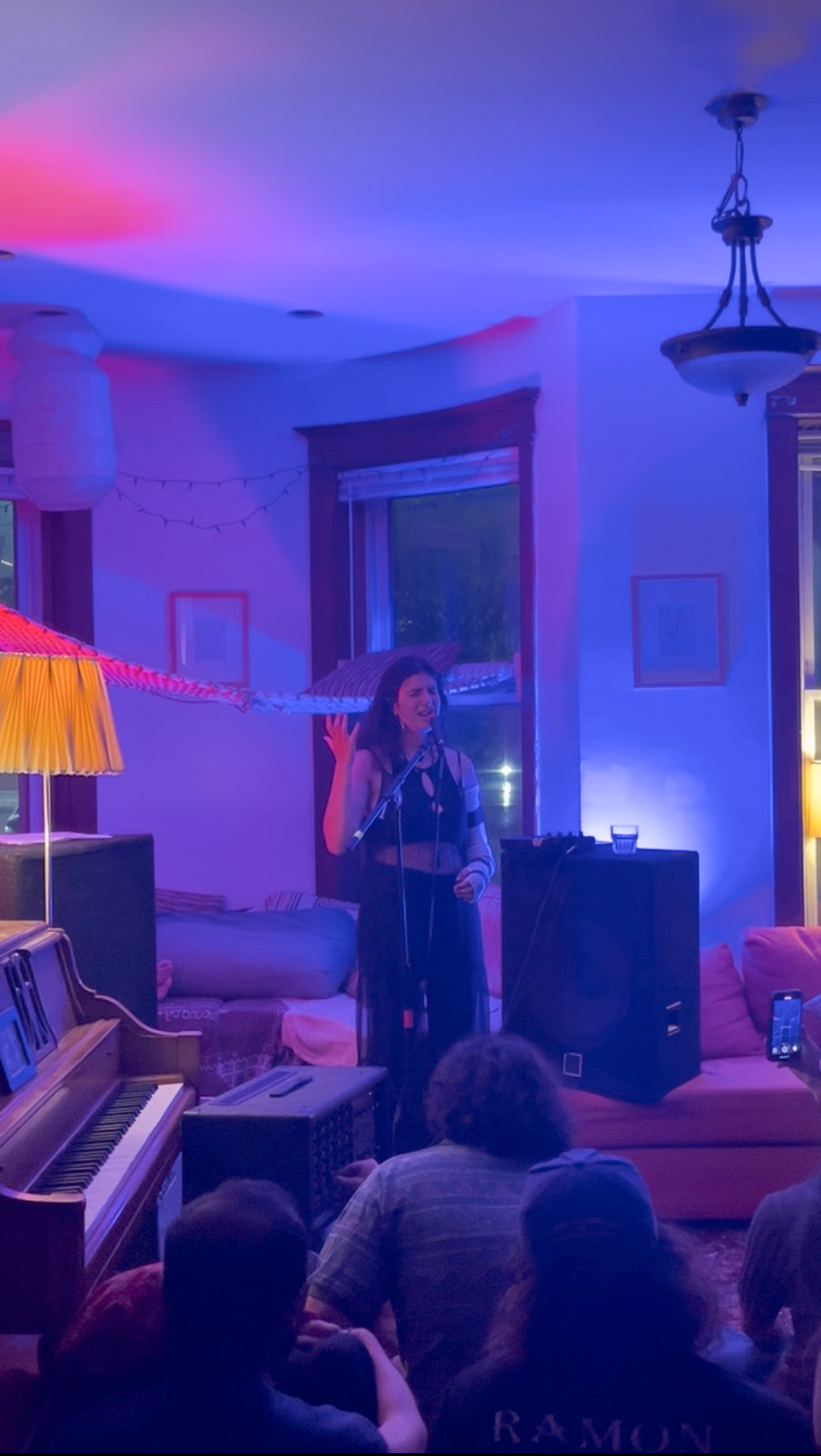Chaia at the Yiddish Electronic release party at Public Records. Photo by Hila Moutsafi.
Dancing Across Genre and Time With Chaia
The musician pairs historic Yiddish folk and klezmer dance music with otherworldly techno grooves.
By Amelia Langas
8.23.2025
I first saw electronic musician Chaia perform at a Chicago house show during a flash flood warning. Her left arm was in a cast from a car accident she’d gotten in just days earlier, but that didn’t impede her performance at all. Tenacious and spirited despite the cast, Chaia sang live and played her songs on a sampler, even leading the crowd in a freylekh, or Yiddish circle dance.
When we met up in the East Village over a month later, she still had that cast but told me it was coming off later that week. Maybe. Nevertheless, she was hitting the road again that weekend to head to KlezKanada’s Summer Retreat, a Yiddish cultural event in Québec. Coincidentally, this year’s festival theme was Yiddish dance, and Chaia was eager to delve into it.
“I'm taking a Yiddish dance fundamental beginner class, and I'm really excited about it,” she told me, her eyes lighting up. “I'm hoping to sit in on as many dance classes as possible and come to a deeper understanding of the medium.”
The vigor with which the New York-based DJ approaches tradition and infuses it with her own contemporary sense fuels her music. Her songs reach deep into the historic channels of Yiddish folk and klezmer dance music, pairing samples and lyrics with otherworldly techno grooves. Chaia honors legacy and history but does not confine herself to it. Not only is she extremely well versed in Jewish cultural knowledge—her father is a Jewish studies teacher, and the Jewish musicians he brought around the house introduced her to Yiddish music—but she also holds profound respect for the Black techno tradition her work intersects with. She notes Detroit music collective Underground Resistance and its founders, including legendary DJs Jeff Mills, Robert Hood, and Mad Mike Banks, as figures who influence her own music. “I found in Black rave culture a similarity to the Jewish music that I grew up with in this collective, ecstatic dance space, community care, and radical traditions,” she said. “Yiddish music has a lot to learn from techno.” It’s fitting, then, that her debut album released in June is called Yiddish Electronic.
Chaia calls Yiddish Electronic her “life’s work.” The result of a collaboration with her close friend, audio engineer Lapis Chala, the album tackles questions of radical existence, connection to the past, and difficult histories. Songs incorporate interview snippets, samples like drumming from first woman klezmer drummer Elaine Hoffman Watts and vocals from Persian singer Galeet Dardashti, and Yiddish folk songs. Each piece comprises many layers, much like the innards of an archive. Chaia compares the tracks to the labels on the front of archival boxes: they sort existing material into categories and then invite listeners to open that box and explore what’s inside by listening. She’s no stranger to archives, specifically the YIVO Institute for Jewish Research, which houses an extensive collection of Yiddish folk songs and klezmer music and is where Chaia conducts much of her sonic research.
The album features seven traditional folk song samples over nine tracks, all in a decidedly anti-authoritarian, anti-fascist vein. The fourth track on the album, “Daloy Politsey,” for example, dips into a historic protest song from socialist and anarchist Jews and literally translates to, “Down with the police.” But Chaia doesn’t simply remix the original song. Instead, she blends it with techno’s familiar four-on-the-floor beat, generating an invigorating and delightfully tempestuous composition. Perhaps what is so striking about this song and the rest of the album is the fusion of genres and histories. But what seems like an unconventional pairing at first—Yiddish folk and electronic dance music—emerges holding hands in the ephemeral community found in social dancing. For Chaia, the best dance floor is one where people submerge themselves in their own presence and histories, invoking theorist DeForrest Brown Jr.’s stance that techno is radical because you can exist in between the beats. “While I’m listening to techno, every part of my life is coming through,” she told me. “I had this experience where I was dancing, and Yiddish songs were coming to me over the beat. That’s why I made this music, to make it audible to everyone else.”
As a dance floor regular myself but a non-Jewish newcomer to klezmer tradition, I was initially reserved about joining the freylekh Chaia led at that Chicago performance. But I needn’t have worried. The folks on either side of me enthusiastically reached for my hands, and we whirled off in ecstatic, movement-centric communion. Ultimately, Chaia wants her audiences to feel called to move in whatever way her music compels them to: “No matter what music you're listening to, you're meant to come at it as yourself.”

Chaia at a Chicago house show.
Photo by Amelia Langas.
